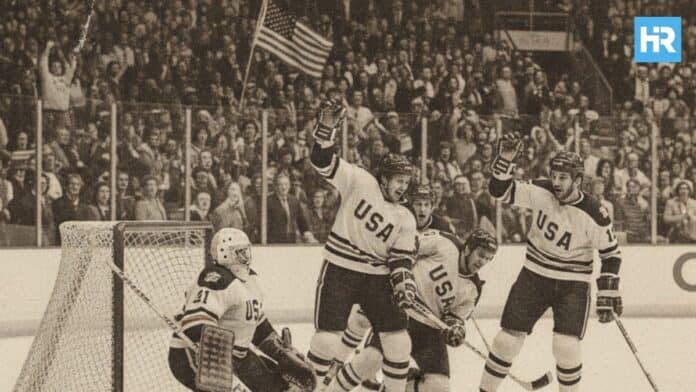On February 22, 1980, inside the Olympic Fieldhouse in Lake Placid, New York, the United States men’s hockey team faced the most dominant team in the world, the Soviet Union. The Americans, average age 22, were college athletes and amateur hopefuls. The Soviets, meanwhile, were seasoned veterans who had won every Olympic gold since 1964 and had not lost a single Olympic game since 1968
By the end of the night, the scoreboard read USA 4, USSR 3, and history had been made. Two days later, the U.S. secured the gold medal with a 4–2 win over Finland. For a country suffering through the Iran hostage crisis, economic uncertainty, and Cold War tension, the Miracle on Ice was a unifying moment. As broadcaster Al Michaels famously declared in the final seconds, “Do you believe in miracles? Yes!”
- On February 22, 1980, the United States Olympic hockey team stunned the world with a 4–3 victory over the Soviet Union before a crowd of 10,000 in Lake Placid.
- Two days later, they secured the gold medal with a 4–2 win against Finland. The roster, composed largely of college players, overcame overwhelming odds against a Soviet team that had dominated Olympic hockey since 1964.
- Their victory became a defining Cold War moment, symbolizing resilience and hope for a struggling America.
The Soviet Dynasty Meets American Amateurs
The Soviet Union came to Lake Placid as four-time defending Olympic champions. Their roster included seven players from the 1976 Olympics and one veteran of three Olympiads. Goaltender Vladislav Tretiak was considered the best in the world, while Boris Mikhailov, Alexander Maltsev, Vladimir Petrov, Vasili Vasiliev, and Valeri Kharlamov were international stars.
The Americans were the opposite. Their captain, Mike Eruzione, had been recruited from the Toledo Blades of the International League. Players like Mark Johnson, Neal Broten, Mark Pavelich, Ken Morrow, Dave Christian, Mike Ramsey, and Buzz Schneider were still in school or just beginning their careers.
The disparity was clear one week before the Olympics when the Soviets demolished the U.S. 10–3 at Madison Square Garden. Few gave the Americans a chance. Yet as Mike Ramsey later insisted, “Maybe we overachieved. But we were a damn good hockey team.”
The Road to the Medal Round
The Americans’ Olympic campaign began with a 2–2 tie against Sweden, salvaged when Bill Baker scored with just 27 seconds remaining. Without that goal, their journey might have ended early, since the U.S. had not beaten Sweden in two decades.
They shocked the world by defeating Czechoslovakia 7–3, with seven different goal scorers. The Czechs, led by the Stastny brothers—Petr, Marian, and Anton, had been considered silver medal contenders.
Wins over Norway and Romania followed, setting up a crucial game against West Germany. Memories of Innsbruck in 1976, when Germany beat the U.S. 4–1, loomed large. The Germans struck early, scoring twice from long distance. Horst-Peter Kretschmer unleashed a 70-foot shot that slipped past Jim Craig, and Udo Kiessling added another from 50 feet.
Craig, rattled but resilient, held steady. Neal Broten tied the game late in the second period, and Rob McClanahan and Phil Verchota added goals in the third for a 4–2 win.
The standings worked against the Americans. To avoid facing the Soviets first, they needed Sweden to lose to Czechoslovakia or to beat Germany by seven goals. Sweden won, and the U.S. managed only a two-goal margin over Germany. The Americans were locked in to face the Soviet Union.
Herb Brooks: Breaking the Myth of Soviet Invincibility
Coach Herb Brooks was as much a psychologist as a strategist. He worked tirelessly to break down the aura surrounding the Soviets. Brooks told his players that Boris Mikhailov, the Soviet captain, looked like Stan Laurel of the Laurel and Hardy comedy duo. “You can beat Stan Laurel, can’t you?” he asked, hoping to make them see their opponents as human rather than invincible.
The team kept a notebook of “Brooksisms,” phrases he used to motivate them. One read, “This team isn’t talented enough to win on talent alone.” Before the game against the Soviets, Brooks wrote a note and read it aloud: “You were born to be a player. You were meant to be here.”
He was not afraid of confrontation. In the opening game against Sweden, Brooks accused Rob McClanahan of being a “cake eater” when he hesitated to play through a leg injury. The two screamed at each other before McClanahan went back on the ice, spurred on by anger. “That locker room scene is still vivid in my mind,” backup goalie Steve Janaszak recalled years later.
Brooks’s methods were harsh, but they worked. His players believed him when he said they could topple the Soviets.
February 22, 1980: The Miracle on Ice
The Soviets began with their trademark speed and skill, scoring first. Buzz Schneider answered with a high shot over Tretiak’s shoulder, but Sergei Makarov restored the Soviet lead. With the first period nearly over, Dave Christian fired the puck on goal. It rebounded off Tretiak’s pads to Mark Johnson, who tied the game 2–2 with one second remaining.
In an astonishing move, Soviet coach Viktor Tikhonov pulled Tretiak and replaced him with Vladimir Myshkin. Years later, Slava Fetisov explained the decision with two words: “Coach crazy.”
In the second period, Alexander Maltsev scored to put the Soviets ahead 3–2. Jim Craig kept the Americans alive with save after save.
The third period brought history. At 8:39, Johnson scored again on a power play to tie the game. Two minutes later, Mark Pavelich passed to Eruzione, who skated into the slot and fired a 25-foot wrist shot through traffic. The puck slipped past Myshkin, and the Americans led 4–3.
In the final 10 minutes, the Soviets unleashed relentless attacks, but Craig turned them aside. As the clock ticked down, fans counted the seconds aloud. When the buzzer sounded, the ice was littered with sticks and gloves as the Americans celebrated. Al Michaels’s voice captured the moment, “Do you believe in miracles? Yes!”
February 24, 1980: Beating Finland for Gold
The Miracle on Ice was not the final step. To win gold, the U.S. still had to defeat Finland two days later. Falling behind 2–1 after two periods, the Americans faced elimination.
Mark Johnson tied the game early in the third. Rob McClanahan followed with the go-ahead goal, and Phil Verchota sealed it. The final score was 4–2, and the Americans had completed their improbable journey. Craig had warned after the Soviet game, “If we don’t win tomorrow, people will forget us.” They did not forget.
The Players Behind the Miracle
Jim Craig was the backbone. Once overlooked, he became the tournament’s standout goaltender. Boston University coach Jack Parker remembered, “When you watched him, it seemed the net had disappeared behind him.”
Mark Johnson, son of legendary coach Bob Johnson, delivered two goals against the Soviets. Known for his calm skill, he earned the nickname “Magic” Johnson of hockey.
The Conehead Line—Mark Pavelich, John Harrington, and Buzz Schneider—played with unpredictable creativity. Eruzione admitted, “I played with them once, and I had no idea what I was doing or where I was going.”
Schneider, at 25, was the oldest player and the only one returning from 1976. After nearly quitting hockey following a failed Penguins tryout, he became one of the team’s quiet leaders and top scorers. “I was the only player in the Penguins camp without a contract,” Schneider recalled. “They only needed me as a practice body.”
The Soviet Union as “Darth Vader on Skates”
The Miracle came at a low point for America. The Iran hostage crisis had dragged on for over 100 days. The Soviet invasion of Afghanistan in December 1979 deepened global tension. At home, inflation and unemployment soared.
The Soviets symbolized the enemy in the Cold War. To many Americans, their athletes were “Darth Vader on skates,” mechanical products of a state system. The victory in Lake Placid symbolized defiance. “For once, Americans were waving a flag,” Eruzione later said.
Where the Players Are Today
Years later, Peter Stastny told Eruzione, “Mike, you fooled us in Lake Placid.” Dave Ogrean recalled wearing a U.S. hockey parka on a flight home and being mistaken for backup goalie Steve Janaszak, who never played a minute in the Games. Ogrean signed napkins in his name. Janaszak laughed when he heard the story, saying, “That means there are probably sixteen napkins out there with my autograph.”
The moment was immortalized in the 2004 film Miracle, with Kurt Russell portraying Herb Brooks. Today, Mike Eruzione serves as Director of Special Outreach at Boston University, Jack O’Callahan works as Senior Managing Director at Ziegler Capital Management, and Rob McClanahan retired in 2023 from Craig-Hallum Capital Group.






